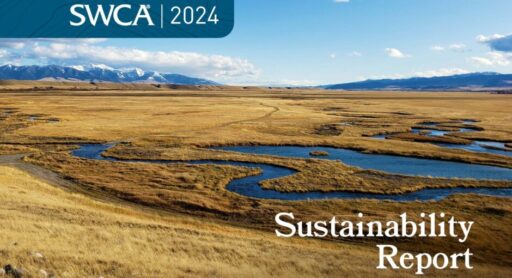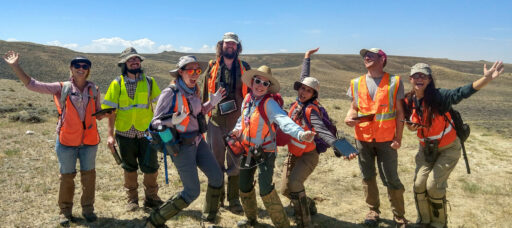2025
Comparably’s Best Company Outlook
* Providing engineering services in these locations through SWCA Environmental Consulting & Engineering, Inc., an affiliate of SWCA.

From the experts we hire, to the clients we partner with, our greatest opportunity for success lies in our ability to bring the best team together for every project.
That’s why:

At SWCA, sustainability means balancing humanity’s social, economic, and environmental needs to provide a healthy planet for future generations.

SWCA employs smart, talented, problem-solvers dedicated to our purpose of preserving natural and cultural resources for tomorrow while enabling projects that benefit people today.

At SWCA, you’re not just an employee. You’re an owner. Everyone you work with has a stake in your success, so your hard work pays off – for the clients, for the company, and for your retirement goals.
EPA and USACE Amend 2023 Rule on WOTUS to Conform with Decision in Sackett v. EPA
Erica Gaddis, Ph.D. serves as SWCA’s Vice President of Scientific & Technical Services, where she leads the company’s technical practice directors and guides enterprise-level strategies focused on scientific excellence, innovation, and career development. In her role, Erica works collaboratively with leaders across SWCA to scale technical capabilities and deliver integrated solutions for clients and communities.
With over 20 years of experience spanning environmental consulting, public service, academia, and international policy, Erica brings a wealth of expertise to her position. A proud SWCA “boomeranger,” she has dedicated a combined 10 years to the company, most recently as Senior Water Resources Technical Director. Her previous roles include Director of Utah’s Division of Water Quality, Senior Policy Advisor to the Western States Water Council, and Principal Scientist at SWCA. She regularly collaborates with the United Nations Environment Programme on integrated environmental assessments. Erica has led numerous projects and programs in water quality, hydrology, watershed management, and water resources planning.

Russell has more than 25 years of experience in environmental regulations compliance for federal, state, and local laws with an understanding of the nuances of FERC regulations and NEPA, CWA, and ESA compliance.

Mr. Hope’s background includes project management, consulting, and field wetland science. His responsibilities with SWCA include project management of generation and transmission projects, compliance with Section 404 of the Clean Water Act, compliance with Section 10 of the River and Harbors Act, and Wetland Delineations. Mr. Hope has experience with working in wetlands across the southeast and has worked extensively with the U.S. Army Corps of Engineers (USACE) Fort Worth District, Galveston District, Mobile District, Vicksburg District, Memphis District, New Orleans District, And Tulsa District.
He has been directly involved in dozens of wind energy, solar energy, battery storage, and transmission line projects in Texas and the southeast. His work has included preparation of environmental assessments (EAs), Nation Wide Permit Applications / Pre-Construction Notifications (PCN), Aquatic resources Delineation Reports, development of mitigation strategies; consultation and coordination with the USACE, U.S. Fish and Wildlife Service (USFWS) and state agencies; field surveys; and aquatic resources mapping. Mr. Hope has represented clients in numerous permit applications for Section 404 of the Clean Water Act and Section 10 of the Rivers and Harbors Act through U.S. Army Corps of Engineers and U.S. Environmental Protection Agency.




The U.S. Environmental Protection Agency (EPA) and U.S. Army Corps of Engineers (USACE) announced an amended rule on August 29, 2023, defining waters of the United States (WOTUS) that conforms with the U.S. Supreme Court’s decision in Sackett v. EPA issued on May 25, 2023.
As stated in EPA’s factsheet, the amended rule:
removes the significant nexus test from consideration when identifying tributaries and other waters as federally protected. It also revises the adjacency test when identifying federally jurisdictional wetlands, clarifies that interstate wetlands do not fall within the interstate waters category, and clarifies the types of features that can be considered under the “additional waters” category.
The definition of WOTUS has been debated since the adoption of the Clean Water Act (CWA) in 1972. Over several decades, regulatory agencies and courts, including the U.S. Supreme Court, have made numerous efforts to interpret the jurisdictional reach of WOTUS under the CWA. The conforming rule will become effective upon publication in the Federal Register. Updates to the rule status are available here: Rule Status and Litigation Update page. The EPA will offer additional information through a recorded webinar on September 12, 2023.
If your project has the potential to impact aquatic resources (e.g., wetlands, streams, lakes, etc.) it is important to consider not only the federal jurisdictional status of the aquatic resources in question but also state and local regulations. Many states and localities across the United States have state regulations that are implemented in addition to CWA regulations. These regulations may require additional permitting and or physical setbacks from aquatic resources.
For more information, you can read the amended rule at EPA.gov. If you have questions about how this decision affects your project, please reach out to your SWCA project manager.